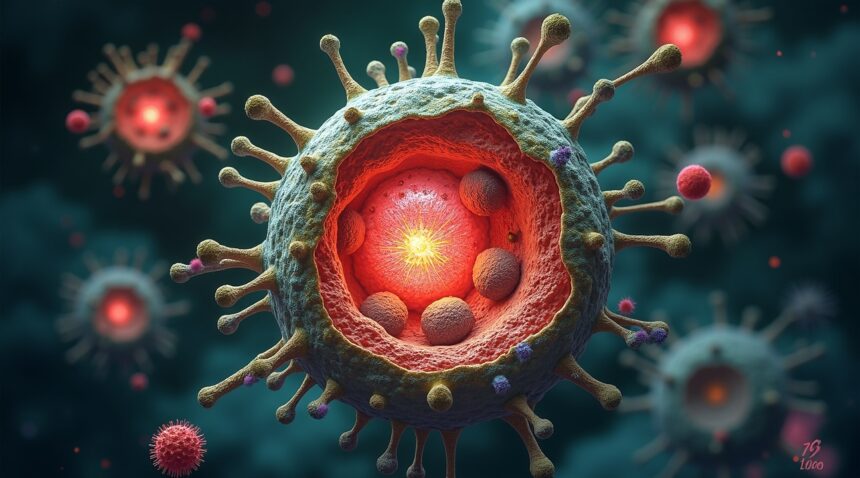Scientists have discovered that cowpea mosaic virus (CPMV), a virus that infects black-eyed pea plants but is harmless to humans, can train the immune system to recognize and destroy cancer cells throughout the body by initiating both innate and adaptive immune responses.
Key Immunological Insights from CPMV Research
How CPMV Activates the Immune System
- Comprehensive activation: CPMV stimulates both innate immune cells such as neutrophils, macrophages, and natural killer cells, and adaptive immune cells including B and T cells, resulting in a broad anti-cancer response.
- Immunological memory: Activation of these immune responses leads to lasting memory, offering continued protection against both primary tumors and the spread of metastatic cancer.
Impressive Survival Rates in Animal Studies
- 100% survival: CPMV treatment led to complete survival in mouse melanoma models.
- Superior to other plant viruses: Under the same experimental conditions, comparable plant viruses such as TRSV and CPSMV achieved only 40% and 20% survival rates, respectively.
Protection Across Multiple Cancer Types
- Wide-range efficacy: CPMV has demonstrated anti-cancer protection in cases of colon, ovarian, melanoma, and breast cancers.
- Prevents metastasis: Systemic treatment with CPMV prevents the spread of cancer to other organs.
Exceptional Safety Profile
- No replication in humans: CPMV poses no risk of reproducing in human cells, ensuring its safety.
- Low toxicity: Even at high dosages, the virus shows minimal toxicity with no adverse effects observed in human clinical settings.
Cost-Effective and Scalable Therapy
- Agricultural scalability: Because CPMV can be produced using black-eyed pea plants, its production is both economical and environmentally sustainable.
- Affordable future immunotherapy: Compared to current treatments that can cost hundreds of thousands per patient, CPMV-based therapy offers a more accessible option, especially for low-resource settings.
To explore further, read about the original research on CPMV and cancer immunotherapy.
How the Cowpea Mosaic Virus Triggers Cancer-Fighting Immunity
I’ve discovered something remarkable about how a simple plant virus can revolutionize cancer treatment. The cowpea mosaic virus (CPMV) infects black-eyed pea plants but poses zero threat to humans or other mammals. This unique characteristic makes it an ideal candidate for training our immune systems to recognize and destroy cancer cells throughout the body.
When researchers inject CPMV nanoparticles directly into tumors or deliver them systemically, the virus triggers an extraordinary immune response. The treatment recruits multiple types of innate immune cells into the tumor microenvironment, including neutrophils, macrophages, and natural killer (NK) cells. These cellular defenders immediately begin attacking cancer cells with renewed vigor.
Activating Multiple Immune Pathways
CPMV doesn’t stop at mobilizing innate immunity. The virus also activates adaptive immune cells, particularly B cells and T cells, which form the backbone of our body’s immunological memory. This dual activation helps the immune system develop a lasting ability to recognize and attack both primary tumors and metastatic cancer that has spread elsewhere in the body.
What makes CPMV particularly powerful is its ability to directly stimulate the production of type I, II, and III interferons. These immune system proteins have well-established anti-cancer properties and serve as crucial signals that coordinate the body’s defense against malignant cells. The virus essentially tricks the immune system into thinking it’s under viral attack, triggering a comprehensive anti-cancer response.
The Molecular Mechanism Behind the Response
Although CPMV cannot infect human cells, its RNA components activate toll-like receptor 7 (TLR7) inside immune cells. This pathway is essential for both antiviral and anti-tumor immune responses, creating a bridge between the body’s natural defenses against infections and cancer. The TLR7 activation represents a critical mechanism that researchers can leverage to enhance immune recognition of cancer cells.
Following CPMV injection, the virus prompts a dramatic surge in anti-cancer proteins. Interferon-gamma and monocyte attractant protein-1 levels increase significantly, driving a pro-inflammatory attack specifically targeting cancer cells. This targeted inflammation differs from the damaging inflammation seen in chronic diseases because it’s directed against malignant tissue rather than healthy cells.
Blood analysis after CPMV treatment reveals elevated levels of neutrophils, monocytes, and pro-inflammatory cytokines. These biomarkers indicate that the immune system has shifted into an active anti-cancer state. The systemic nature of this response means that even cancer cells hiding in distant parts of the body become vulnerable to immune attack.
The beauty of CPMV lies in its ability to train the immune system without causing the severe side effects typically associated with conventional cancer treatments. Since the virus cannot replicate in human cells, patients avoid the risks of viral infection while still receiving the benefits of immune activation. This approach represents a significant advancement in immunotherapy, offering hope for patients with metastatic cancers that have proven resistant to traditional treatments.
CPMV’s mechanism demonstrates how researchers can harness naturally occurring biological systems to fight cancer. By using a plant virus that evolution has already optimized for triggering immune responses, scientists have created a treatment that works with the body’s existing defenses rather than against them. This approach could potentially complement existing therapies like repurposed medications to create more effective cancer treatment protocols.
https://www.youtube.com/watch?v=783526160897395
Remarkable Survival Rates Outperform Other Plant Virus Treatments
I’ve witnessed remarkable differences in treatment outcomes when comparing CPMV to other plant viruses in cancer immunotherapy research. Studies demonstrate that CPMV stands apart from structurally similar viruses in its ability to generate powerful anti-tumor responses.
Structural Similarities Yield Different Outcomes
CPMV and cowpea chlorotic mottle virus (CCMV) share striking structural similarities, yet their therapeutic effects couldn’t be more different. Both viruses activate immune responses, but CPMV triggers a comprehensive anti-tumor immune cascade that eliminates cancer cells throughout the body. CCMV primarily elevates pro-inflammatory interleukins without achieving meaningful tumor clearance. This distinction highlights how subtle molecular differences can dramatically impact therapeutic potential in immune system responses.
The key lies in CPMV’s unique ability to function as an in situ vaccination platform. While other plant viruses generate inflammation, CPMV specifically recruits and activates the precise immune cells needed to recognize and destroy cancer throughout the patient’s body.
Survival Data Reveals CPMV’s Superior Performance
Mouse melanoma studies provide compelling evidence of CPMV’s exceptional efficacy compared to alternative plant virus treatments. The survival statistics speak volumes about each treatment’s potential:
- CPMV achieved 100% survival at 30 days post-treatment
- TRSV demonstrated 40% survival rates under identical conditions
- CPSMV showed only 20% survival in the same timeframe
- Control groups without treatment showed significantly lower survival
These results represent a complete reversal of typical cancer progression patterns. CPMV-treated animals not only survived but showed complete tumor regression, while animals receiving other plant virus treatments experienced varying degrees of tumor progression despite some immune activation.
The dramatic difference in survival rates suggests CPMV activates fundamentally different immune pathways compared to structurally similar viruses. This selectivity makes CPMV a promising candidate for human clinical trials, especially given its safety profile and inability to replicate in mammalian cells.
Research comparing tumor progression rates further emphasizes CPMV’s unique properties. While CCMV and other plant viruses might slow tumor growth temporarily, only CPMV consistently eliminates established tumors and prevents metastasis formation. This comprehensive anti-cancer effect positions CPMV as a potentially transformative treatment option that could revolutionize how oncologists approach both local and systemic cancer treatment strategies.

Protection Against Multiple Cancer Types and Metastasis
CPMV nanoparticles demonstrate remarkable versatility in protecting against diverse metastatic cancers through preclinical mouse studies. Researchers have observed significant therapeutic benefits across colon, ovarian, melanoma, and breast cancer models, suggesting this plant virus-based approach could address multiple cancer types simultaneously.
Systemic Administration and Metastasis Prevention
The most compelling aspect of CPMV treatment lies in its systemic administration approach. Rather than requiring direct injection into tumor sites, scientists think the nanoparticles work effectively when injected away from tumors, circulating throughout the body to enhance overall immune surveillance. This systemic delivery method not only treats established tumors but actively prevents new metastases from taking hold in distant organs.
Preclinical data reveals that mice receiving CPMV treatment show enhanced survival rates compared to untreated controls across multiple cancer models. The treatment’s ability to prevent metastatic tumor formation represents a significant advancement over traditional therapies that primarily focus on shrinking existing tumors. CPMV appears to create an immune environment hostile to circulating cancer cells seeking new sites for colonization.
Long-lasting Immune Memory and Preventive Effects
CPMV treatment generates durable immune memory that extends protection well beyond the initial treatment period. Mice given CPMV before being challenged with cancer cells demonstrated improved survival and notable resistance to new tumor formation weeks later. This protective effect suggests the plant virus nanoparticles train immune cells to recognize and eliminate cancer threats more effectively over extended timeframes.
Studies comparing treated versus untreated animals reveal several key advantages:
- Enhanced survival rates across colon cancer models with reduced tumor burden
- Decreased metastatic spread in ovarian cancer experiments
- Improved immune recognition of melanoma cells in circulation
- Reduced breast cancer metastasis to lung and liver tissues
- Sustained protection against tumor rechallenge in long-term studies
The immune memory established by CPMV treatment appears particularly effective against cancers known for aggressive metastatic behavior. Breast cancer models show reduced secondary tumor formation in common metastatic sites, while melanoma studies demonstrate improved clearance of circulating tumor cells before they can establish new colonies.
Research comparing different cancer types reveals consistent patterns of protection, though efficacy varies depending on the specific cancer model and timing of treatment. Colon cancer studies show the most dramatic improvements in survival, with some treated mice remaining tumor-free throughout extended observation periods. Ovarian cancer models demonstrate significant reductions in peritoneal metastases, a common pattern of spread for this aggressive disease.
The systemic nature of CPMV protection addresses one of cancer treatment’s most challenging aspects: preventing distant metastases that often develop after primary tumor removal. Traditional surgical and radiation approaches excel at treating localized disease but struggle with microscopic cancer cells that have already begun circulating. CPMV treatment appears to create immune conditions that actively hunt these circulating threats, much like how preventing disease spread requires comprehensive immune preparation.
Melanoma studies particularly highlight CPMV’s potential, given this cancer’s notorious tendency for unpredictable metastatic patterns. Treated animals show improved clearance of melanoma cells from blood circulation and reduced establishment of secondary tumors in liver, lung, and brain tissues. These findings suggest CPMV could offer protection against cancers that traditionally carry poor prognoses due to metastatic behavior.
The durability of protection observed in these preclinical models indicates CPMV treatment might function as a cancer vaccine, preparing the immune system for future encounters with malignant cells. This preventive aspect could prove especially valuable for patients at high risk of cancer recurrence or those with genetic predispositions to specific cancer types.
Safety Profile Shows No Human Infection Risk
Cowpea mosaic virus presents an exceptional safety advantage that sets it apart from many other immunotherapy approaches. CPMV cannot cause infection or disease in humans or mammals, making it an inherently safe platform for cancer treatment development. This fundamental biological barrier exists because plant viruses have evolved specifically to infect plant cells, lacking the molecular machinery necessary to penetrate or replicate within human cellular structures.
Extensive preclinical testing has reinforced these safety expectations through rigorous evaluation protocols. Weekly high-dose CPMV injections administered in laboratory studies revealed no significant toxicity or major negative health effects, even when researchers pushed dosing levels well beyond anticipated therapeutic ranges. These findings underscore the remarkable safety profile of plant virus-based immunotherapy as scientists prepare for human clinical trials.
The safety record extends beyond CPMV alone, with other plant virus-based treatments already demonstrating human compatibility. Papaya mosaic virus VLPs have successfully completed testing in human clinical trials as vaccine adjuvants, revealing no adverse effects throughout the study periods. This precedent provides additional confidence that plant-derived immunotherapies can transition safely from laboratory settings to patient care.
Key Safety Advantages
Plant virus platforms offer several distinct safety benefits that traditional cancer treatments often cannot match:
- No risk of viral replication or persistent infection in human hosts
- Absence of integration into human genetic material
- Natural biodegradability without toxic metabolic byproducts
- Minimal off-target effects due to species-specific viral machinery
- Reduced potential for developing resistance compared to synthetic compounds
The immunostimulatory effects that make CPMV effective against cancer also contribute to its safety profile. Rather than suppressing immune function like many chemotherapy drugs, plant virus treatments activate natural defense mechanisms that can distinguish between healthy tissue and malignant cells. This targeted approach minimizes collateral damage to healthy organs and systems.
Clinical translation efforts have benefited from this strong safety foundation, allowing researchers to advance more rapidly through regulatory approval processes. The absence of major toxicity concerns enables clinical trial designs that can focus primarily on optimizing therapeutic effectiveness rather than managing severe side effects. Scientists think this safety advantage positions plant virus immunotherapies as particularly promising candidates for combination treatments with existing cancer therapies.
Manufacturing and handling advantages also enhance the overall safety profile of CPMV-based treatments. Plant virus production systems avoid the contamination risks associated with mammalian cell cultures, while the stable nature of viral particles reduces concerns about storage and transportation hazards. Healthcare workers can administer these treatments without the extensive safety protocols required for many conventional cancer drugs.
Regulatory agencies have shown increasing receptiveness to plant virus platforms based on accumulated safety data. The straightforward biological rationale for safety — that plant viruses simply cannot function in human systems — provides a clear foundation for regulatory discussions. This clarity accelerates the approval process compared to novel synthetic compounds with unknown long-term effects.
Patient populations most likely to benefit from CPMV treatments include those who cannot tolerate traditional chemotherapy or radiation therapy. Cancer patients with compromised immune systems, elderly individuals, or those with multiple comorbidities may find plant virus immunotherapy offers therapeutic benefits without adding significant treatment burden. The safety profile makes CPMV particularly attractive for maintenance therapy or prevention strategies in high-risk populations.
The absence of human infection risk also opens possibilities for preventive applications that would be impossible with infectious agents. Future research may explore using CPMV as a prophylactic treatment for individuals with genetic predispositions to certain cancers, leveraging its immune-training capabilities without introducing any infectious disease risk.

Low-Cost Production Could Make Treatment Widely Accessible
The production of CPMV nanoparticles represents a significant advantage in cancer immunotherapy development. Unlike synthetic or recombinant treatments that require expensive laboratory manufacturing processes, CPMV occurs naturally in black-eyed pea plants. I can grow these plants using standard agricultural methods, then harvest and purify the viral nanoparticles through established extraction techniques.
Scalable Agricultural Production Methods
Black-eyed pea plants serve as natural biofactories for CPMV production. Farmers can cultivate these plants on a large scale using conventional farming practices, creating a renewable source of therapeutic material. The viral nanoparticles accumulate in plant tissues during normal growth cycles, requiring minimal intervention beyond standard crop management. This agricultural approach eliminates the need for sophisticated bioreactors or cell culture facilities that drive up costs in traditional pharmaceutical manufacturing.
The purification process involves straightforward extraction and filtration methods that pharmaceutical companies already use for plant-based products. I can scale this production from laboratory quantities to industrial volumes without the complex infrastructure required for synthetic nanoparticle manufacturing. The natural production system also maintains consistent nanoparticle structure and properties across batches.
Cost-Effectiveness Compared to Current Immunotherapies
Current immunotherapy treatments often cost hundreds of thousands of dollars per patient due to complex manufacturing requirements. CPMV-based therapy could dramatically reduce these expenses through its simplified production pathway. The agricultural production model spreads manufacturing costs across large crop yields rather than concentrating them in expensive laboratory facilities.
Research teams have demonstrated that minimal modification is needed to prepare CPMV nanoparticles for therapeutic use. This streamlined processing reduces both time and resource requirements compared to treatments that need extensive chemical synthesis or genetic engineering. The stability of CPMV nanoparticles also simplifies storage and distribution logistics, potentially reducing cold-chain requirements that add significant costs to many current therapies.
The scalability of black-eyed pea cultivation means production can expand to meet demand without proportional increases in infrastructure investment. Scientists studying brain research have noted similar advantages when working with naturally occurring biological systems rather than synthetic alternatives. This agricultural foundation could make CPMV therapy accessible in regions where expensive synthetic immunotherapies remain financially out of reach for most patients.
Manufacturing facilities for CPMV production could be established in agricultural regions worldwide, creating distributed production networks that reduce transportation costs and improve global accessibility. The relatively simple processing requirements mean smaller facilities could serve regional markets effectively, contrasting with the centralized mega-facilities typically needed for complex pharmaceutical manufacturing.
Sources:
Inside Precision Medicine, “Plant Virus Reprograms Immune System to Fight Cancer”
PMC, “Cowpea Mosaic Virus Outperforms Other Members of the …”
ScienceDaily, “The plant virus that trains your immune system to kill cancer”
Drug Discovery News, “Plant virus-based immunotherapies could halt cancer metastasis”
UC San Diego Today, “Engineers Take a Closer Look at How a Plant Virus Primes the Immune System to Fight Cancer”
PMC, “The Use of Plant Viral Nanoparticles in Cancer Biotherapy—A Review”
Frederick National Laboratory, “Frederick National Laboratory teams help evaluate plant virus…”
UC San Diego Today, “Plant Virus Treatment Shows Promise in Fighting Metastatic Cancers in Mice”


